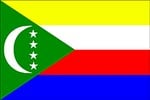Includes historical data for Comoros’ Gross Domestic Product growth, debt-to-GDP ratio and more, as well as information on trade, banking and financial sector leadership.
Young Population And Retail Powered Economy
With a population of about 1 million people, half of whom are under 20 years of age, Comoros is a densely populated archipelagic country consisting of three islands off Africa’s east coast in the Indian Ocean. Following over 20 coups or coup attempts since achieving independence from France in the 1970s, today Comoros is striving to solidify political stability and leverage its tourism prospects to alleviate poverty.
Yet, the country’s location makes it one of the most climate-vulnerable in the world, with large parts of the population living in at-risk areas and facing poverty and food insecurity. The majority of the labor force remains engaged in agriculture, with spice exports being a significant component of government revenue subject to the global commodity market’s price fluctuations. Small retail and accommodation services are other drivers of the economy. Ineffective macroeconomic policies, lack of transparency, and the prevalence of informal labor activities continue to impede economic progress and hinder private sector initiatives.
Macroeconomy & Sovereign Data
| Type of Government | Federal presidential republic |
|---|---|
| Capital | Moroni |
| Sovereign Ratings |
S&P: Not rated Moody’s: Not rated Fitch: Not rated |
| Total Population | 1.0 million |
| Median Age | 20.7 |
| Adult Per Capita Income (PPP) | 6,985.18 |
| Total GDP (2023) | 1.4 billion |
Comoros GDP & Economic Overview
Most Recent Content
Comoros
Banking & Finance
Trade & Investment
| Total Exports | USD 394.8 million (2023) |
|---|---|
| Leading Exports |
Cloves Tug Boats Essential Oils Scrap Vessels Vanilla |
| Total Imports | USD 57.7 million (2022) |
| Leading Imports |
Rice Chicken Products Refined Petroleum Cement Cars |
| Source: | World Integrated Trade Solution |
Comoros Leading Companies
| Banque de Développement des Comores | Financials |
|---|---|
| Banque pour l’Industrie et le Commerce | Financials |
| Société Comorienne de Distribution | Consumer Staples Distribution & Retail |
| Société Comorienne des Hydrocarbures | Oil & Gas Distribution & Marketing |
| Societe Nationale des Telecommunications | Telecommunication Services |
| Comoros Port Authority | Transportation Infrastructure Services |
Major Trade Partners — Import
| United Arab Emirates | 43% |
|---|---|
| France | 11% |
| Pakistan | 7% |
| China | 6% |
| India | 4% |
Source: World Integrated Trade Solution
Major Trade Partners — Export
| India | 25% |
|---|---|
| Tanzania | 21% |
| France | 20% |
| United States | 6% |
| Germany | 5% |
Source: World Integrated Trade Solution
Global Finance Rankings & Awards
Data Sources:
UN World Population Prospects
World Inequality Report
S&P Global Ratings
Moody’s
Fitch Ratings
IMF Direction of Trade Statistics (DOTS)
UN Conference on Trade and Development (UNCTAD)
CIA The World Factbook
World Bank’s World Integrated Trade Solution
Forbes Global 2000




